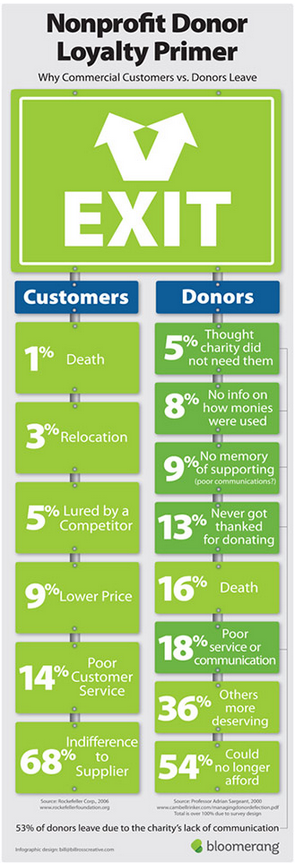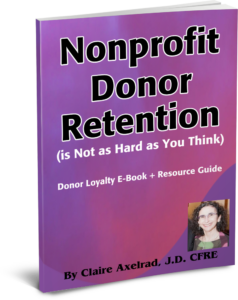
It costs more to acquire a new donor than retain a current one.
A lot more.
In fact, research shows it takes 7 – 12% more effort, time and money to bring in a new donor than to raise more from a current donor.
Please, please, please… let this sink in.
The for-profit world understands this.
It’s why they retain, on average, 80 – 90% of current customers.
People who vape are buying more e-cigarettes.
People who buy sugary soda are buying more sugary soda.
People who own Apple phones are buying more Apple phones.
The list goes on and on.
For-profits know they must spend money to make money.
Net/net it’s a win.
Why Do You Keep Giving Customers Away?
For-profit businesses understand the economic sense of putting resources into building loyalty.
They learn as much as they can about their customers likes, dislikes, habits, preferences and yearnings. They communicate frequently, offering all sorts of benefits and rewards. They engage personally, and do all they can to give customers a dopamine rush so they feel really good about making the same purchase decision again. And again, and again.
For some reason, much of the non-profit world still doesn’t get it.
Which is why the results for the social benefit sector are the opposite of their for-profit counterparts.
Per the Fundraising Effectiveness Project, less than 20% of new donors (aka customers) are retained.
Can you imagine what would happen to Apple, Amazon, and Domino’s Pizza if 8 out of 10 customers never purchased from them again?
They’d be out of business.
Now, perhaps your nonprofit does want to go out of business one day – when hunger is no more… when no one has to live on the streets… when a cure for cancer is found… when no one discriminates against or takes advantage of another… But, that day is not now.
Now, when it’s too soon, the trajectory many critically-needed nonprofits are on is the prematurely-going-out-of-business (or at least not growing and serving all you could serve) route.
I’ve been reporting this for over a decade, but things are only getting worse.
Is losing more donors than you keep inevitable?
NO!
If for-profit businesses can learn how to retain the vast majority of their customers, so can non-profit businesses. After all, you compete in the same marketplace for cash and loyalty.
So, why the huge discrepancy?
Nonprofits Do a Lousy Job Communicating
Per this graphic representation of years of research into donor retention by Adrian Sargeant, together with Bloomerang and others, the lion’s share of the reasons donors stop giving have to do with the way nonprofits communicate with them.
Or, better put, the way they fail to effectively communicate with them.

You can’t control death, but you can control for the other variables.
-
People who say they don’t think you need them are saying you didn’t make an effective case for support. Or, perhaps, you didn’t show your appreciation.
-
People who say they didn’t receive info on how their gift was used mean just that. If you believe you communicated this, take another look at what you sent. Was it specific to their gift? Or a generic, “canned” thank you or a mass email they likely didn’t open?
-
People who say they’ve no memory of supporting you mean you failed to make an impression of any kind after they donated.
-
People who say they were never thanked may in fact have been neglected by you. If you believe you thanked them, take a look at what you sent. It may have been perceived as a transactional receipt, or even sounded more like another appeal than a thank you.
-
People who received poor service may mean any of the above. Or it may mean they encountered staff who were not part of a culture of philanthropy. They weren’t listened to, they were passed from person to person, no one responded to them, or any number of “we don’t really care about you” missteps.
-
People who believed others were more deserving mean you didn’t make the case that your nonprofit really needed their support as much as another charity, perhaps one even operating in your same space.
-
People who could no longer afford giving to you also means you likely didn’t make an effective case for support. Because it’s hard to believe a majority of your donors suddenly fell on hard times. They’re likely still buying pizza and soda — things they want; they just haven’t been inspired – by you – to want what you offer. If they believed you would fix the problem that keeps them up at night, they’d make other economic adjustments before cutting you off.
Your Communication Habits Leave Money on the Table
By not communicating effectively, you’re leaving money on the table.
Donors tell us this all the time, both with words and actions.
When respected researcher Penelope Burk asked donors why they stopped giving, or why they gave less than they could, they were not shy about how they felt. Here are some of their responses:
Why donors stopped giving
“I didn’t receive any information at all after making a gift to a not-for-profit last year. I wonder what they did with the money and whether it helped.”
“What my friends and I talk about is how donors who make smaller gift are dismissed as unimportant.”
“I’ve narrowed my giving down to organizations that issue informative and concise reports about what they are achieving with donors’ contributions.”
“Last year I had one of the most positive experiences ever after donating to a relief agency that was intervening in a disaster that had affected our out-of-state friends. After giving, I received email updates that always included expressions of appreciation for my contribution. The organization described how they were helping those affected by the disaster, and how their services would be evolving over time. The tone of every communication was positive and respectful. As I result, I will give them another gift this year, even though I do not live in the area in which they work.”
“I am very impressed with their follow-up. To have the organization thank me and explain how the dollars were used WITHOUT asking for more money actually made me want to give more.”
Donor Loyalty Must Be Proactively Built
Stop making the excuse you don’t have the resources for-profit businesses have.
That’s not why they retain customers and you don’t.
They build loyalty because they work at it!
You can too.
It only takes the will to do so.
This means doing everything in your power.
Every New Donor is an Opportunity
Every time you acquire a new donor you acquire an opportunity for a repeat donor.
A good one!
Did you know you’ve less than a 2% chance of acquiring a new donor but a 60-70% chance of securing a donation from someone who’s already given?
It won’t happen if you take your donors for granted.
Alas, that’s what most nonprofits do.
Maybe you think you’re the exception.
Maybe you actually are.
But… double check this.
Are You Seizing Your Opportunity?
Repeat donors won’t just fall into your lap.
Especially not if you treat donors like gumballs; chew ‘em up, spit ‘em out.
Take some time to admire your new gumball and appreciate all its qualities (size, shape, color, flavor, the joy it brings you).
It’s time to rethink your approach to donor relationships.
When it comes to driving repeat and upgraded donations, seizing your opportunity is the least you can do.
The Real Driver of Loyalty is Visceral Connection
Loyalty is the new nonprofit donor currency. Build a proactive strategic plan to show donors how strong the connection is between the values you enact and the values they share.
You must budget to develop a loyalty-building plan.
If you want to evolve and grow, reframe your process for connecting with folks.
Don’t simply budget for donor acquisition, leaving retention to take care of itself.
Sadly, it won’t.
Unless you change your strategies, your newly acquired donors will take their dollars and spend them on pizza, soda, cigarettes, soap and… other charities doing a more effective job connecting with them to build their loyalty.
Want to Learn More to Drive Donor Loyalty?
 Grab the Donor Retention and Gratitude Playbook. I invite you to join me for an easy, step-by-step, six-volume journey where you’ll learn how to make a great first impression — and then a terrific second, third and fourth impression — by thanking, praising and engaging with your donors in a manner that makes them want to stay loyal to you.
Grab the Donor Retention and Gratitude Playbook. I invite you to join me for an easy, step-by-step, six-volume journey where you’ll learn how to make a great first impression — and then a terrific second, third and fourth impression — by thanking, praising and engaging with your donors in a manner that makes them want to stay loyal to you.
NOTE: You can purchase the volumes separately, but you get a bargain if you buy the bundle. And, by the way, if you’re an enrolled Clairification School student you save almost 50%. So, if you’re not enrolled, do that first! Then come back and grab your guidebook.
As with any Clairification purchase, if you’re not satisfied for any reason you have my no-questions-asked, 30-day, 100% refund guarantee.
Image: Three San Francisco Hearts. The Beat Goes On. Seat of Emotion. Midnight Rhapsody. Benefit for San Francisco General Hospital Foundation.
#Put #Real #Resources #Building #Nonprofit #Donor #Loyalty








